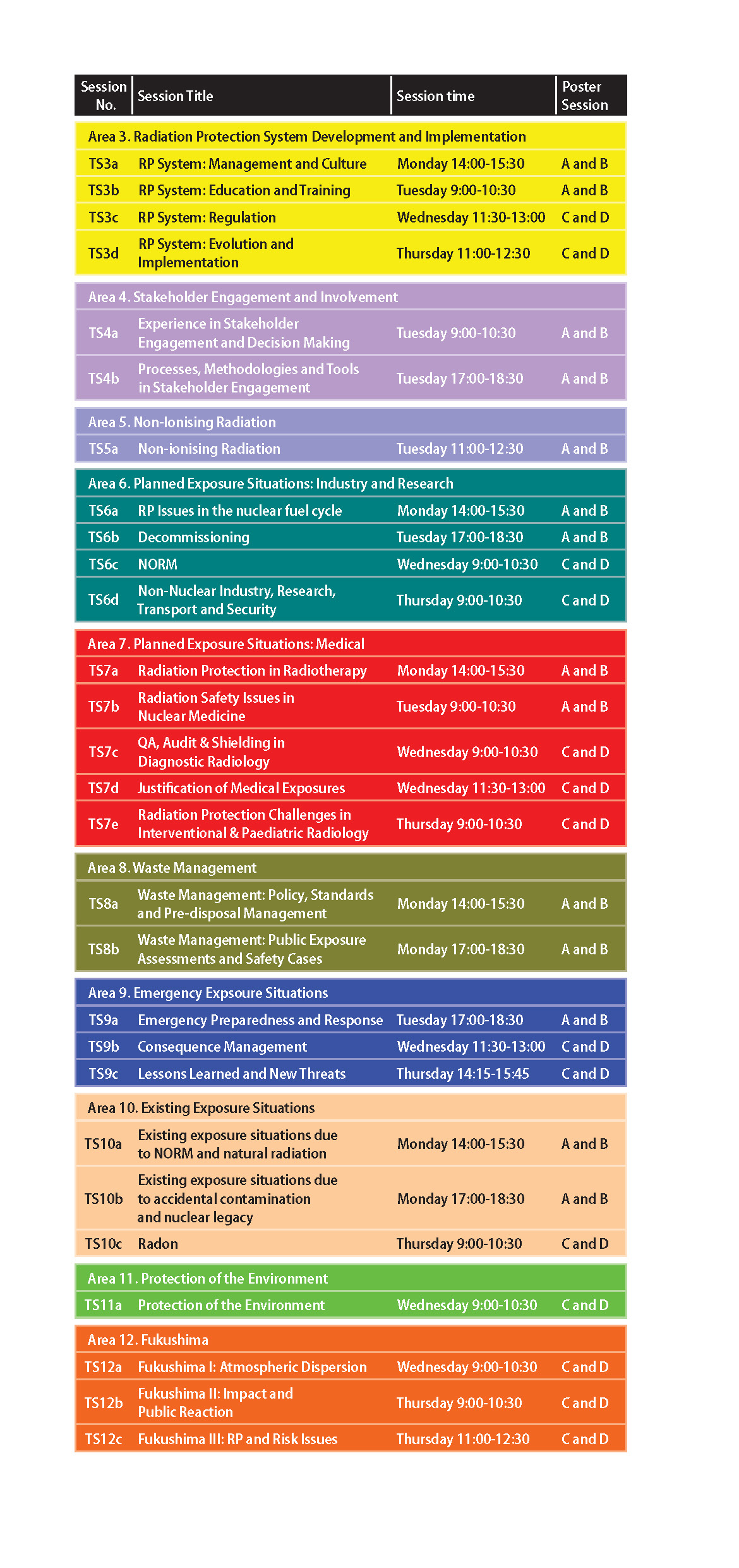Scientific Programme


This presents an overview of the whole Congress, with the programme arranged in plenaries and parallel sessions (up to six sessions at a time). The schedule was colour-coded according to the technical area of each session.
Download the IRPA13 Abstract Book
Plenary Sessions
In addition to the formal Opening and Closing Ceremonies there were the following plenary sessions. These sessions, by the world’s leading scientists and practitioners in their fields, presented overviews of the current state of key topics in radiation protection:
- Sievert Lecture: Richard Osborne ‘A Story of Tritium’
- Underpinning Science: State of the Art
- Engaging with Society
- The System of Protection
- Lessons and Challenges following the Fukushima Accident
- IRPA Activities
Key Issue Discussion Sessions
These explored the current key issues in specific topics through expert discussion, and helped us move towards the principal conclusions from the Congress. Key issues were discussed in the following Topic Areas:
- KIDS 1 - Underpinning Science
- KIDS 3 - The System of Protection
- KIDS 4 - Stakeholder Engagement
- KIDS 6 - Nuclear Industry
- KIDS 7 - Exposures in Medicine
Technical Sessions
Submitted papers which were selected for oral presentation were allocated within these sessions. Each of the 38 Technical Sessions aligned with a defined section of the Area/Topic map:
- TS 1a - Radiation Biology
- TS 1b - Epidemiology
- TS 1c - Human Health Effects and Risk Factors
- TS 2a - External Exposure Assessment
- TS 2b - Internal Exposure Assessment
- TS 2c - Biological Dosimetry and Modelling
- TS 2d - Instrumentation and Measurement I
- TS 2e - Instrumentation and Measurement II
- TS 2f - Metrology and Dosimetry
- TS 2g - Numerical and Computational Dosimetry
- TS 3a - RP System: Evolution and Implementation
- TS 3b - RP System: Regulations and Standards
- TS 3c - RP System: Management and Culture
- TS 3d - RP System: Education and Training
- TS 4a - Experience in Stakeholder Engagement and Decision Making
- TS 4b - Processes, Methodologies and Tools in Stakeholder Engagement
- TS 5a - Non-Ionising Radiation
- TS 6a - RP Issues in the nuclear fuel cycle
- TS 6b - Decommissioning
- TS 6c - NORM in Mining and Industry
- TS 6d - Non-Nuclear Industry, Research, Transport and Security
- TS 7a - Radiation Protection in Radiotherapy
- TS 7b - Radiation Safety Issues in Nuclear Medicine
- TS 7c - QA, Audit & Shielding in Diagnostic Radiology
- TS 7d - Justification of Medical Exposures
- TS 7e - Radiation Protection Challenges in Interventional & Paediatric Radiology
- TS 8a - Waste Management: Policy/Strategy & Standards, Pre-disposal, Clearance & Exemption
- TS 8b - Waste Management: Discharges & Public Exposure Assessment, Waste Storage & Waste Disposal Facilities
- TS 9a - Emergency Preparedness and Response
- TS 9b - Emergency Consequence Management
- TS 9c - Emergencies: Lessons Learned & New Threats
- TS 10a - Existing exposure situations due to NORM and natural radiation
- TS 10b - Existing exposure situations due to accidental contamination and nuclear legacy - long term management and remediation
- TS 10c - Radon
- TS 11a - Protection of the Environment
- TS 12a - Fukushima: Overview and Dispersion of Radioactive Material
- TS 12b - Fukushima: Emergency Planning and Communications
- TS 12c - Fukushima: Monitoring and Dose Assessment
Poster Sessions
Those submitted papers not selected for oral presentation were allocated for poster presentation, arranged within Topic Areas. The posters were divided into two groups, each poster being displayed for two days – either Monday/Tuesday or Wednesday/Thursday. It was requested that all posters were submitted electronically in PDF format and could therefore be downloaded and viewed by delegates at any time during the Congress (although not all authors complied). Provided that a poster PDF was available, authors were given the option of not providing a paper. Rapporteurs also presented key features from the posters during the relevant Technical Session.
Symposia
Selected topics of current significance were addressed through specific sessions with invited speakers and wider discussions.
- S 3.1 - Radiation Protection Culture
- S 4.1 - Affected Populations Experiences
- S 4.2 - Teaching Radiation Protection in Schools
- S 7.1 - Medical Risk and the Public
- S 8.1 - Stakeholder Involvement in Waste Management
- S 9.1 - Medical Countermeasures against Serious Radiation Exposure
- S 10.1 - Radon Exposure
- S 11.1 - Protection of the Environment
- S 12.1 - Japan Health Physics Society Fukushima Symposium
Fora
Key current aspects of the work of our sister international organizations were explored in these sessions.
- F 2.1 - Dosimetry and Measurement - ICRU
- F 3.1 - Ethics and Values in Radiation Protection - ICRP/NEA
- F 3.2 - Legal Aspects of Radiation Protection - INLA
- F 6.1 - Worker Education and Training - IAEA/ILO/NEA
- F 6.2 - Safety and Security of Sources - WINS
- F 6.3 - Nuclear Industry Forum - WNA
- F 7.1 - Role of the Qualified Expert in Hospitals - IOMP
- F 7.2 - Global Health Care Perspectives - IAEA/WHO/PAHO
Refresher Courses and Workshops
The Refresher Course programme, together with two Workshops, provided delegates with the opportunity to update their knowledge in specific areas of radiation protection science and practice.
Congress Conclusions
A brief summary of key points from the Congress was presented in the final plenary session. A more detailed document presenting the Congress Conclusions was prepared by the Topic Area Leads and the ICPC which, after a period of consultation, was published in the December 2012 edition of the Journal of Radiological Protection.
The final plenary session also presented an overview of the current IRPA activities.